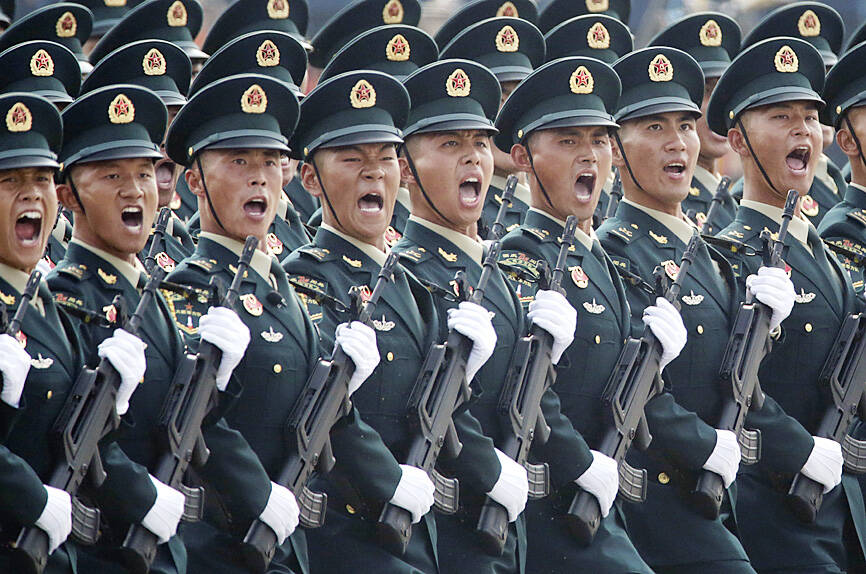The Chinese military has boosted its capability to fight at a high tempo using the element of surprise and new technology, the Ministry of National Defense said in the Quadrennial Defense Review (QDR) published on Monday last week.
The ministry highlighted Chinese People’s Liberation Army (PLA) developments showing significant changes in Beijing’s strategy for war on Taiwan.
The PLA has made significant headway in building capabilities for all-weather, multi-domain intelligence, surveillance, operational control and a joint air-sea blockade against Taiwan’s lines of communication, it said.

Photo: Jason Lee, Reuters
The PLA has also improved its capabilities in direct amphibious assault operations aimed at seizing strategically important beaches, ports and bases, and has combined novel and conventional technology in multiple layers, it said.
It has worked on enhancing the cooperation between military and civilian society to enable a rapid transition to a wartime footing, it said, adding that it continued to build its strategic weapons arsenal to deter international intervention in the Taiwan Strait.
China has been building navy and coast guard offshore patrol vessels en masse, which could be used to isolate important ports from strategic materials and commerce, the ministry said.
The PLA Navy could also be rapidly deployed to blockade or shape conditions for a formal attack on Taiwan proper, it said.
China plans to mobilize civilian transport vessels to assist military operations, which could resolve its lack of logistical capabilities, the ministry said, adding that it could conceal signs of an invasion preparation.
The PLA would be able to hide from prying eyes its transition to war and shorten the time Taiwan would have to prepare for a fight, it said.
Identifying the signs of a Chinese invasion has become difficult for Taiwan, the ministry said.
The prevalence of commercial satellites allows for unprecedented observation and geolocation capabilities that has made the battlefield transparent, it said.
The armed forces must be mobile, agile and capable of dispersing or concentrating as needed, to preserve its force under enemy fire, it said, adding that it must also focus on building flexible and agile capabilities to enable the rapid dispersal or concentration of combat power.
Long-range and uncrewed weapon systems allow precision strikes at longer ranges and give more choices in delivery, blurring the line between the front and rear areas, it said.
The protection of logistics lines has become key to winning offensive and defensive operations on a battlefield where troops are sure to consume huge amounts of ammunition and supplies, the ministry said.
The PLA’s electronic warfare combined with hard-kill capabilities pose a severe threat to the nation’s armed forces, it said.
The military must have secure communication, and geolocation and navigation systems to deploy and preserve combat power, the ministry said.
Drones, including “smart” loitering munitions, have brought significant changes to land warfare and air defense, it said, adding that uncrewed aerial and naval vehicles could be used to attack maritime targets or conduct long-range strikes.
China would use conventional, mixed and unconventional forces should a war break out, it said.
For Taiwan, mounting an effective defense depends on whole-of-society support, rapid mobilization of military and civilian capabilities, and ensuring the government and essential services survive, the ministry said.

‘DENIAL DEFENSE’: The US would increase its military presence with uncrewed ships, and submarines, while boosting defense in the Indo-Pacific, a Pete Hegseth memo said The US is reorienting its military strategy to focus primarily on deterring a potential Chinese invasion of Taiwan, a memo signed by US Secretary of Defense Pete Hegseth showed. The memo also called on Taiwan to increase its defense spending. The document, known as the “Interim National Defense Strategic Guidance,” was distributed this month and detailed the national defense plans of US President Donald Trump’s administration, an article in the Washington Post said on Saturday. It outlines how the US can prepare for a potential war with China and defend itself from threats in the “near abroad,” including Greenland and the Panama

The Chinese Nationalist Party (KMT) is maintaining close ties with Beijing, the Democratic Progressive Party (DPP) said yesterday, hours after a new round of Chinese military drills in the Taiwan Strait began. Political parties in a democracy have a responsibility to be loyal to the nation and defend its sovereignty, DPP spokesman Justin Wu (吳崢) told a news conference in Taipei. His comments came hours after Beijing announced via Chinese state media that the Chinese People’s Liberation Army’s Eastern Theater Command was holding large-scale drills simulating a multi-pronged attack on Taiwan. Contrary to the KMT’s claims that it is staunchly anti-communist, KMT Deputy

RESPONSE: The government would investigate incidents of Taiwanese entertainers in China promoting CCP propaganda online in contravention of the law, the source said Taiwanese entertainers living in China who are found to have contravened cross-strait regulations or collaborated with the Chinese Communist Party (CCP) could be subject to fines, a source said on Sunday. Several Taiwanese entertainers have posted on the social media platform Sina Weibo saying that Taiwan “must be returned” to China, and sharing news articles from Chinese state media. In response, the Mainland Affairs Council (MAC) has asked the Ministry of Culture to investigate whether the entertainers had contravened any laws, and asked for them to be questioned upon their return to Taiwan, an official familiar with the matter said. To curb repeated

A magnitude 4.9 earthquake struck off Tainan at 11:47am today, the Central Weather Administration (CWA) said. The hypocenter was 32.3km northeast of Tainan City Hall at a depth of 7.3km, CWA data showed. The intensity of the quake, which gauges the actual effect of a seismic event, measured 4 in Tainan and Chiayi County on Taiwan's seven-tier intensity scale, the data showed. The quake had an intensity of 3 in Chiayi City and County, and Yunlin County, while it was measured as 2 in Kaohsiung, Nantou County, Changhua County, Taitung County and offshore Penghu County, the data showed. There were no immediate reports of